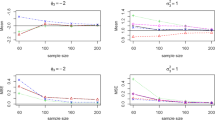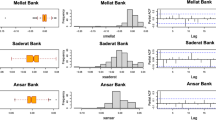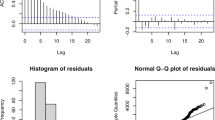Abstract
This paper is concerned with the estimation problem of a periodic autoregressive model with closed skew-normal innovations. The closed skew-normal (CSN) distribution has some useful properties similar to those of the Gaussian distribution. Maximum likelihood (ML), Maximum a posteriori (MAP) and Bayesian approaches are proposed and compared in order to estimate the model parameters. For the Bayesian approach, the Gibbs sampling algorithm and for computing the ML and MAP estimations, the expectation–maximization algorithms are performed. The simulation studies are then conducted to compare the frequentist average losses of competing estimators and to study the asymptotic properties of the given estimators. The proposed model and methods developed in this paper are also applied to a real time series. The accuracy of the CSN and Gaussian models is compared by cross validation criterion.








Similar content being viewed by others
References
Arellano-Valle RB, Azzalini A (2006) On the unification of families of skew-normal distributions. J Stat Theory Appl 33(3):561–574
Azzalini A (1985) A class of distribution which includes the normal ones. Scand J Stat 12(2):171–178
Azzalini A (2005) The skew normal distribution and related multivariate families. Scand J Stat 32(2):159–200 (with discussion)
Azzalini A, Capitanio A (1999) Statistical applications of the multivariate skew-normal distribution. J R Stat Soc B 61:579–602
Azzalini A, Dalla Valle A (1996) The multivariate skew-normal distribution. Biometrika 83:715–726
Basawa IV, Lund RB (2001) Large sample properties of parameter estimates for periodic arma models. J Time Ser Anal 22:651–663
Bayes CL, Branco MD (2007) Bayesian inference for the skewness parameter of the scalar skew-normal distribution. Braz J Probab Stat 21:141–163
Bondon P (2009) Estimation of autoregressive models with epsilon-skew-normal innovations. J Multivar Anal 100(8):1761–1776
Broszkiewicz-Suwaj E, Makagon A, Weron R, Wylomanska A (2004) On detecting and modeling periodic correlation in financial data. Physica A 336(1–2):196–205
Chaari F, Leskow J, Napolitano A, Sanchez-Ramirez A (eds) (2014) Cyclostationarity: theory and methods. Lecture notes in mechanical engineering. Springer, Cham
Chaari F, Leskow J, Napolitano A, Zimroz R, Wylomanska A, Dudek A (eds) (2015) Cyclostatioarity: theory and methods II. Applied condition monitoring. Springer, Cham
Chaari F, Leskow J, Napolitano A, Zimroz R, Wylomanska A (eds) (2017) Cyclostationarity: theory and methods III. Applied condition monitoring. Springer, Cham
Franses PH (1996) Periodicity and stochastic trends in economic time series. Oxford University Press, Oxford
Franses PH, Paap R (1994) Model selection in periodic autoregressive. Oxf Bull Econ Stat 56(4):421–439
Franses PH, Paap R (2004) Periodic time series models. Oxford University Press, Oxford
Gardner WA (1994) Cyclostationarity in communications and signal processing. IEEE Press, New York
Gauvain J, Lee C (1994) Maximum a posteriori estimation for multivariate Gaussian mixture observations of markov Chains. IEEE Trans Speech Audio Process 2(2):291–298
Gebizlioglu OL, Senoglu B, Kantar YM (2011) Comparison of certain value-at-risk estimation methods for the two-parameter Weibull loss distribution. J Comput Appl Math 235(11):3304–3314
Genton ME (2004) Skew elliptical distributions and their applications: a journey beyond normality. CRC, London
Gladyshev EG (1961) Periodically correlated random sequences. Sov Math 2:385–388
González-Farías G, Domı́nguez-Molina J, Gupta A (2004) Additive properties of skew normal random vectors. J Stat Plan Inference 126:521–534
Hipel KW, Mcleod AI (1994) Time series modelling of water resources and environmental systems. Elsevier, Amsterdam
Hurd HL, Miamee A (2007) Periodically correlated random sequences: spectral theory and practice. Wiley, Hoboken
Li WK, McLeod AI (1988) ARMA modelling with non-Gaussian innovations. J Time Ser Anal 9(2):155–168
Liu C, Rubin DB (1994) The ECME algorithm: a simple extension of EM and ECM with faster monotone convergence. Biometrika 81:633–648
Lund RB, Basawa IV (2000) Recursive prediction and likelihood evaluation for periodic arma models. J Time Ser Anal 21:75–93
Lund R, Shao Q, Basawa I (2006) Parsimonious periodic time series models. Aust N Z J Stat 48(1):33–47
Lutkepohl H (2005) New introduction to multiple time series analysis. Springer, Berlin
Maleki M, Arellano-Valle RB (2017) Maximum a posteriori estimation of autoregressive processes based on finite mixtures of scale-mixtures of skew-normal distributions. J Stat Comput Simul 87(2):1061–1083
Maleki M, Arellano-Valle RB, Dey DK, Mahmoudi MR, Jalili SMJ (2018) A Bayesian approach to robust skewed autoregressive processes. Calcutta Stat Assoc Bull 69(2):165–182
Manouchehri T, Nematollahi AR (2019) On the estimation problem of periodic autoregressive time series: symmetric and asymmetric innovations. J Stat Comput Simul 89(1):71–97
McLeod AI (1993) Parsimony, model adequacy, and periodic autocorrelation in time series forecasting. Int Stat Rev 61:387–393
Mcleod AI (1994) Diagnostic checking of periodic autoregression models with application. J Time Ser Anal 15(2):221–233
Meng XL, Rubin DB (1993) Maximum likelihood estimation via the ECM algorithm: a general framework. Biometrika 80:267–278
Nematollahi AR, Soltani AR (2000) Discrete time periodically correlated Markov processes. Math Stat 20:127–140
Nematollahi AR, Soltani AR, Mahmoudi MR (2017) Periodically correlated modeling by means of the periodograms asymptotic distributions. Stat Pap 1(1):1–12
Ni S, Sun D (2003) Noninformative priors and frequentist risks of bayesian estimators of vector-autoregressive models. J Econom 115:159–197
Noakes DJ, McLeod AI, Hipel KW (1985) Forecasting monthly river-flow time series. Int J Forecast 1:179–190
Novales A, de Frutto RF (1997) Forecasting with periodic models: a comparison with time invariant coefficient models. Int J Forecast 13:393–405
Osborn D, Smith J (1989) The performance of periodic autoregressive models in forecasting seasonal U.K. consumption. J Bus Econ Stat 7:117–127
Pagano M (1978) On periodic and multiple autoregressions. Ann Stat 6:1310–1317
Pourahmadi M (2007) Skew-normal ARMA models with nonlinear heteroscedastic predictors. Commun Stat Theory Methods 36:1803–1819
Serpedin E, Panduru F, Sarı I, Giannakis GB (2005) Bibliography on cyclostationarity. Signal Process 85(12):2233–2303
Shao Q (2006) Mixture periodic autoregressive time series models. Stat Probab Lett 76(6):609–618
Shao Q (2007) Robust estimation for periodic autoregressive time series. J Time Ser Anal 29:251–263
Sharafi M, Nematollahi AR (2016) AR(1) model with skew-normal innovations. Metrika 79(8):1011–1029
Sun D, Ni S (2004) Bayesian analysis of vector-autoregressive models with noninformative priors. J Stat Plan Inference 121(2):291–309
Sun D, Ni S (2005) Bayesian estimates for vector autoregressive models. J Bus Econ Stat 23(1):105–117
Tolpin D, Wood F (2015) Maximum a posteriori estimation by search in probabilistic programs. In: The 8th annual symposium on combinatorial search will take place in EinGedi, the Dead Sea, Israel, from June 11–13, 2015. The proceedings and workshop technical reports will be published by AAAI Press
Troutman BM (1979) Some results in periodic autoregression. Biometrika 66:219–228
Ursu E, Duchesne P (2009) On modelling and diagnostic checking of vector periodic autoregressive time series models. J Time Ser Anal 30:70–96
Ursu E, Turkman KF (2012) Periodic autoregressive model identification using genetic algorithm. J Time Ser Anal 33:398–405
Vecchia AV (1985a) Periodic autoregressive-moving average (PARMA) modeling with applications to water resources. Water Resour Bull 21:721–730
Vecchia AV (1985b) Maximum likelihood estimation for periodic autoregressive moving average models. Technometrics 27:375–384
White M, Wen J, Bowling M, Schuurmans D (2015) Optimal estimation of multivariate ARMA models. In: Proceedings of the twenty-ninth AAAI conference on artificial intelligence
Author information
Authors and Affiliations
Corresponding author
Additional information
Publisher's Note
Springer Nature remains neutral with regard to jurisdictional claims in published maps and institutional affiliations.
Appendices
Appendix A: Proof of Theorem 3.1
In order to prove of Theorem 3.1, we need some preliminary definitions and properties.
Definition 1
(Truncated multivariate normal). If \( \varvec{W} \sim N_{q} \left( {\varvec{\mu},{\varvec{\Sigma}}} \right) \) and \( \varvec{U} = \left\{ {\begin{array}{*{20}l} \varvec{W} & {if\quad \varvec{W} \ge \varvec{c}} \\ {\mathbf{0}} & {if\quad ~\varvec{W} < \varvec{c}} \\ \end{array} } \right. \) where \( \varvec{W} \ge \varvec{c} \) means \( W_{j} \ge c_{j} , j = 1, \ldots ,q \), then the density function of \( \varvec{U} \) is:
\( \varvec{U} \) is truncated multivariate normal denote by \( \varvec{U} \sim N_{q}^{\varvec{c}} \left( {\varvec{\mu},{\varvec{\Sigma}}} \right) \).
Property 1
If \( \varvec{U} \sim N_{q}^{\varvec{c}} \left( {\varvec{\mu},{\varvec{\Sigma}}} \right) \) then the moment generating function of \( \varvec{U} \) is given by
Property 2
If\( \varvec{Z} \sim CSN_{p,q} \left( {\varvec{\mu},\varvec{\varSigma},\varvec{\varGamma},\varvec{\nu},\varvec{\varDelta}} \right) \), then the moment generative function of\( \varvec{Z} \)is given in González-Farías et al. (2004) as
Proof of Theorem 3.1
The result of part (a) is proved by using the uniqueness property of the moment generating functions. Note that
where \( \varvec{Z} \sim CSN_{T,T} \left( {\mathop \sum \limits_{j = 1}^{P}\varvec{\varPhi}_{j} \varvec{y}_{t - j} ,\varvec{\varSigma}^{*} ,\varvec{\varGamma}^{*} ,{\mathbf{0}},\varvec{I}_{\varvec{T}} } \right) \).
(b) It is proved by using the linearity property of the multivariate normal distributions.
(c) It can be proved by the following arguments:
where \( {\varvec{\Lambda}}^{*} = \left( {\varvec{\varLambda}^{ - 1} + \varvec{D^{\prime}G}^{ - 1} \varvec{D}} \right)^{ - 1} \), \( \varvec{\nu}^{*} = {\varvec{\Lambda}}^{*} \varvec{D^{\prime}G}^{ - 1} \left( {\varvec{y}_{t} - \mathop \sum \limits_{j = 1}^{P}\varvec{\varPhi}_{j} \varvec{y}_{t - j} } \right) \), and \( C \) is function of parameters \( \varvec{\theta}_{1} = \left( {\varvec{\varPhi}_{j} ,{\varvec{\Lambda}},\varvec{G},\varvec{D}} \right) \) and observed data \( \varvec{y}_{t} \).
The moment generating function of \( \varvec{W}_{t} |\varvec{Y}_{t} \) is given by
and so
where
Therefore
where \( \xi_{1} = \frac{{\frac{{\partial \varPhi_{T} \left( {\varvec{s}; -\varvec{\nu}^{*} ,{\varvec{\Lambda}}^{*} } \right)}}{{\partial \varvec{s}}}}}{{\varPhi_{T} \left( {0; -\varvec{\nu}^{*} ,{\varvec{\Lambda}}^{*} } \right)}}|_{{\varvec{s} = 0}} . \) Also,
Where
Therefore
where \( \xi_{2} = \frac{{\frac{{\partial^{2} \varPhi_{T} \left( {\varvec{s}; -\varvec{\nu}^{*} ,{\varvec{\Lambda}}^{*} } \right)}}{{\partial \varvec{s}\partial \varvec{s^{\prime}}}}}}{{\varPhi_{T} \left( {0; -\varvec{\nu}^{*} ,{\varvec{\Lambda}}^{*} } \right)}}|_{{\varvec{s} = \varvec{s^{\prime}} = 0}} . \)
Appendix B. Algorithm CJJ
Step 1 Compute \( \varvec{\nu}_{{\left( {k + 1} \right)}} = \varvec{I}_{T} \) and \( \varvec{m}_{{\left( {k + 1} \right)}} =\varvec{\alpha}_{k} {\varvec{\Delta}}_{k}^{ - 1/2}\varvec{\varPhi}_{0k}^{\varvec{'}} \left( {\varvec{Y}_{ - P} - \varvec{Z}_{ - P} {\varvec{\Phi}}_{k} } \right).\varvec{ } \) Simulate \( \varvec{W}_{k + 1} \) from a multivariate truncated normal with mean \( \varvec{m}_{{\left( {k + 1} \right)}} \) and \( T \times T \) variance–covariance matrix \( \varvec{\nu}_{k + 1} \).
Step 2 Select a \( T \)-dimention random vector \( \varvec{V}_{1} \) with elements \( v_{1i} = z_{1i} /( {\mathop \sum \limits_{j} z_{1j}^{2} } )^{1/2} \), where, \( z_{1i} \), \( 1 \le i \le T \) are \( iid \sim N\left( {0,1} \right) \). Generate \( \lambda_{1} \sim N\left( {0,1} \right) \) and set \( {\varvec{\Upsilon}}_{1} =\varvec{\varPhi}_{k} + \lambda_{1} \varvec{V}_{1} \). Compute
Simulate \( u_{1} \sim {\text{Unif}}\left( {0,1} \right) \). If \( u_{1} \le { \hbox{min} }\left( {1,{ \exp }\left( {\tau_{k + 1} } \right)} \right) \)., let \( \varvec{\varPhi}_{k + 1} = {\varvec{\Upsilon}}_{1} \). Otherwise, let \( \varvec{\varPhi}_{k + 1} =\varvec{\varPhi}_{k} \).
Step 3 Decompose \( {\varvec{\Sigma}}_{k} = \varvec{ODO^{\prime}} \), where, \( \varvec{D} = {\text{diag}}( {d_{1} , \ldots ,d_{T} }) \), \( d_{1} \ge d_{2} \ge \ldots \ge d_{T} \), and \( \varvec{OO^{\prime}} = \varvec{I} \). Let \( d_{i}^{*} = { \log }\left( {d_{i} } \right) \), \( \varvec{D}^{*} = {\text{diag}}\left( {d_{1}^{*} , \ldots ,d_{T}^{*} } \right) \) and \( {\varvec{\Sigma}}_{k}^{*} = \varvec{OD}^{*} \varvec{O^{\prime}}. \)
Select a random symmetric \( T \times T \) matrix \( \varvec{V}_{2} \) with elements \( v_{2ij} = z_{2ij} /( {\mathop \sum \nolimits_{l \le m} z_{2lm}^{2} } )^{1/2} \), where, \( z_{2ij} \), \( 1 \le i \le j \le T \times \left( {T + 1} \right)/2 \), are \( iid \sim N\left( {0,1} \right) \). (the other elements of \( \varvec{V}_{2} \) are defined by symmetry).
Generate \( \lambda_{2} \sim N\left( {0,1} \right) \) and set \( {\varvec{\Upsilon}}_{2} = {\varvec{\Sigma}}_{k}^{*} + \lambda_{2} \varvec{V}_{2} \). Decompose \( {\varvec{\Upsilon}}_{2} = \varvec{QC}^{*} \varvec{Q^{\prime}} \), where, \( \varvec{C}^{*} = diag( {c_{1}^{*} , \ldots ,c_{T}^{*} }) \), \( c_{1}^{*} \ge c_{2}^{*} \ge \ldots \ge c_{T}^{*} \), and \( \varvec{QQ^{\prime} } = \varvec{I} \). Compute
Simulate \( u_{2} \sim {\text{Unif}}\left( {0,1} \right) \). If \( u_{2} \le { \hbox{min} }\left( {1,exp\left( {\tau_{k + 1} } \right)} \right) \), let \( {\varvec{\Sigma}}_{k + 1}^{*} = {\varvec{\Upsilon}}_{2} \), \( \varvec{C} = {\text{diag}}\left( {e^{{c_{1}^{*} }} , \ldots ,e^{{c_{T}^{*} }} } \right) \) and \( {\varvec{\Sigma}}_{k + 1} = \varvec{QCQ^{\prime}} \). Otherwise, let \( {\varvec{\Sigma}}_{k + 1}^{*} = {\varvec{\Sigma}}_{k}^{*} \) and \( {\varvec{\Sigma}}_{k + 1} = {\varvec{\Sigma}}_{k} \).
Step 4 Select a \( T \)-dimention random vector \( \varvec{V}_{3} \) with elements \( v_{3i} = z_{3i} /( {\mathop \sum \limits_{j} z_{3j}^{2} } )^{1/2} \), where, \( z_{3i} \), \( 1 \le i \le T \) are \( iid \sim N\left( {0,1} \right) \). Generate \( \lambda_{3} \sim N\left( {0,1} \right) \) and set \( {\varvec{\Upsilon}}_{3} =\varvec{\alpha}_{k} + \lambda_{3} \varvec{V}_{3} \). Compute
Simulate \( u_{3} \sim {\text{Unif}}\left( {0,1} \right) \). If \( u_{3} \le { \hbox{min} }\left( {1,exp\left( {\tau_{k + 1} } \right)} \right) \), let \( \varvec{\alpha}_{k + 1} = {\varvec{\Upsilon}}_{3} \). Otherwise, let \( \varvec{\alpha}_{k + 1} =\varvec{\alpha}_{k} \).
Rights and permissions
About this article
Cite this article
Manouchehri, T., Nematollahi, A.R. Periodic autoregressive models with closed skew-normal innovations. Comput Stat 34, 1183–1213 (2019). https://doi.org/10.1007/s00180-019-00893-z
Received:
Accepted:
Published:
Issue Date:
DOI: https://doi.org/10.1007/s00180-019-00893-z




